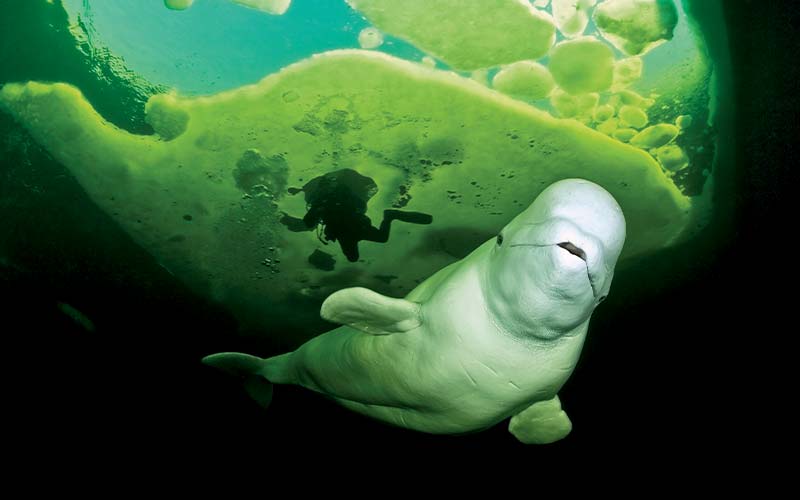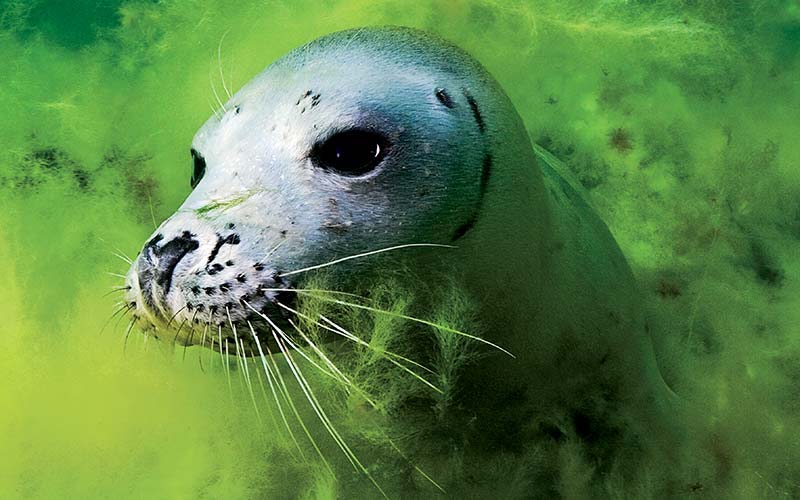The body of work presently being generated by underwater photographers worldwide is inspiring, even for those of us who have been pursuing marine images all our adult lives. We see it on the scuba-centric websites, on personal blogs, in social media like Facebook and in print in dive magazines. To rise to the top in such a sea of talent is challenging — even more so when the standard has been set so very high, as it has been in the Ocean Views photo competition.
Established in 2008 by Nature’s Best Photography magazine, the Ocean Views contest quickly established a reputation for excellence in the quality of submissions and the respectful elegance with which the magazine presented the winners. In 2010 the concept of a collaborative photo contest between Nature’s Best and Alert Diver emerged, with the winning images appearing as significant portfolios in both magazines.
I feel privileged to have been able to assist with judging this contest these past two years, although prioritizing excellence among so many brilliant submissions is a daunting challenge. Seeing these thousands of images is a virtual tour of some of the top dive attractions on the planet, rendered with photographic excellence by passionate enthusiasts.
There is no way to calculate the miles traveled or the hours invested in capturing the images represented on the following pages and our companion gallery. Nor can we even imagine the post-production time spent editing and processing these digital photos. We can, however, admire their artistry and envy the dive adventures that brought these shooters to these frozen moments in time.
—Stephen Frink
First Place

Franco Banfi, Cadro, Switzerland — Beluga whale (Delphinapterus leucas), Arctic Circle Dive Center, White Sea, Karelia, Russia (photo at the top).
“When it comes to taking pictures in cold temperatures under the ice, many factors are considered: light, clarity of the water, lens choice, strobes, ISO. I decided for a fast ISO, to get some natural light in the frame, and the fisheye lens, considering the size of the subject and the particles in the water. I used two strobes with long arms to capture the playful creature.”
Canon EOS-1Ds Mark II; 15mm f/2.8 fisheye lens; 1/125 sec at f/5.6; ISO 200; Seacam Seaflash 150 strobes at half power (2); Seacam housing. www.banfi.ch

Second Place
Toshio Minami, Tokyo, Japan — Spinner dolphins, Ogasawara (Bonin) Islands south of Tokyo, Japan
“I took this photograph of the spinner dolphins in the calm water. Dolphins and a cloud were reflected in the sea. When the sun appeared through the breaks in cloudiness for an instant, our shadow was reflected in the surface of the sea, and we and the sea were united with the sky.”
Canon EOS 20D; EF-S 10-22mm lens at 22mm; 1/640 sec at f/5.6; ISO 200; hand held.
Third Place
Kaido Haagen, Tallinn, Estonia — Gray seal (Halichoerus grypus), Vilsandi Island, Estonia

“Eutrophication is a major environmental problem of the Baltic Sea. Excess nutrients from agricultural activity in the region lead to an abundance of algal and marine plant growth. The resulting decline in oxygenation of the water can cause serious harm to populations of other species, including gray seals.”
Canon EOS 400D; EF-S 10-22mm f/3.5-4.5 USM lens at 17mm; 1/60 sec at f/16; Ikelite Substrobe DS125 (2); Ikelite housing. www.kaidohaagen.com
Fourth Place
Mark van Coller, Cape Town, South Africa — Cape gannet diving for sardines during the Sardine Run 2010, off Port St Johns, Eastern Cape, South Africa

“This image was taken during the sardine run, which happens annually along the east coast of South Africa during the winter months. The Cape gannet is just one of a number of predators that congregate and rely on this event. The common dolphins are the ringmasters of the event; they herd the sardines into a tight formation known as a bait ball, which all the other predators can then feed on. What makes this image different is that it was shot during the fading light of day when the sun was just setting, giving the water a beautiful orange glow.”
Canon EOS 5D Mark II; EF 16-35mm f/2.8 II USM lens at 22mm; 1/200 sec at f/11; ISO 400; Sea & Sea YS-250PRO strobe; Sea & Sea YS-110a strobe; Zen 8″ Optical Glass Dome Port; Ultralight Control Systems strobe arm; Subal housing.

Fifth Place
Christian Loader, Southwick, West Sussex, United Kingdom — Leafy seadragon, Victor Harbour, South Australia, Australia
“Leafy seadragons are endemic to the south and west coasts of Australia and are incredibly shy, always turning away from you. After a freezing 60-minute dive (with shaking, numb hands), this seadragon got used to my presence and allowed me to get the head-on shot I was after to capture the eye contact with this beautiful animal.”
Nikon D300; 60mm lens; 1/125 sec at f/14; ISO 200; Inon Z-240 strobes; Nexus housing. www.scubazoo.com
Sixth Place
Quincy Dein, Maui, Hawaii — Forrest Dein riding a wave, Makena Beach, Maui, Hawaii

“While the shore break at Makena Beach is notoriously dangerous and powerful, it also makes for some amazing images. On this particular morning I grabbed my brother, Forrest, and convinced him to ride a couple of waves on his boogie board just as the sun came over the crest of Haleakala. When shooting barreling shore break, anything can go wrong: water drops on the lens, tilted camera angle, scratches on the port from all the sand, and spray from the wave blurring the image. As this particular wave came in and jacked up on the sand bar, I knew it was going to be something special. I am really thrilled with how this image turned out!”
Canon EOS-1D Mark IV; 15mm fisheye lens; 1/1250 sec at f/6.3; ISO 250; CMT housing www.quincydein.com
Seventh Place

Todd Mintz, Regina, Saskatchewan, Canada — Sockeye salmon (Oncorhynchus nerka), Adams River, British Columbia, Canada
“Every four years the sockeye salmon have their large spawning run; 2010 was the largest on record in 100 years with more than 30 million. The salmon travel inland from the Pacific Ocean about 500 kilometers to spawn, fighting currents and uphill climbs. The salmon begin to change to the brilliant red and green color, and the male sockeyes’ jaws begin to hook in preparation to attract a female. At the end of this journey the salmon spawn and then die (which can be an equally amazing sight and smell). I waited most of the morning on this day for the sun’s position to line up where I needed it. I then quietly slipped into the river and fought against the rushing Adams River current to position in front of the salmon as they hugged the shore just outside the main river current. The water temperature was very cold as this was mid-October, and we required drysuits to extend our in-water time.”
Canon EOS 50D; Tokina 10-17mm fisheye lens; 1/125 sec at f/14; ISO 320; Seatool housing; Inon Z-240 strobes (2). www.tmintz.com
Honorable Mentions

Jenn Broom, Roberts Creek, British Columbia, Canada — Humpback whale, Great Bear Rainforest, British Columbia
“We were traveling by sailboat in the Great Bear Rainforest on the coast of British Columbia when we spotted some humpback whales. We stopped, turned off the engine and waited to see what the whales would do. Soon a group of three whales approached. They were moving beside and below the boat and were surfacing close by. I wanted a shot that included the whole whale, the bow of the boat and the people enjoying the scene, so I had the skipper haul me 30 feet up the mast. This was my first shot in the series — a whale came up where I hoped it would, and I captured this image.”
Panasonic Lumix DMC-GF1; Panasonic Lumix G Vario 14-45mm f/3.5-5.6 lens at 16mm (EFL = 32mm); 1/100 sec at f/6.3; ISO 100; hand held. www.oceanlight2.bc.ca
Nuno Sá, Ponta Delgada, Portugal — Devil rays (Mobula tarapacana) and divers, Santa Maria Island, Azores, Portugal

“Devil rays can be seen in large groups in the clear blue waters of the Azores, especially in remote underwater seamounts that rise from great depths almost to the surface. This topography creates an ascending current that brings waters rich in microscopic plankton to the surface; the devil rays gather in these areas and gently swim around, filtrating the water. To take this picture I went to one of these places with two professional freedivers who, with a breath in their lungs, calmly glided among them.”
Canon EOS 5D; Sigma 15mm lens; 1/125 sec at f/8; ISO 320; Aquatica housing. www.photonunosa.com

Phil Sokol, San Diego, Calif. — Atlantic sailfish, Isla Mujeres, Mexico
“Go, go, go!” shouted the captain, and we leapt off the small sport fishing boat into the water. We had been following a large group of sailfish near Isla Mujeres off Mexico’s Yucatan peninsula for more than an hour, but now the bait ball they had been slowly picking away at was down to just a few dozen fish. The predators flashed their sails and slashed their bills at the bait trying to stun a single fish and separate it from the rest, and as the frenzied baitfish swam close to me, I was able to capture this ‘Gotcha!’ moment.”
Canon EOS 50D; Tokina 10-17mm lens at 10mm; 1/250 sec at f/6.3; ISO 400; natural light; Subal C40 housing.
Jon Cornforth, Seattle, Wash. — Humpback whale breaching, Frederick Sound, Alaska

“A juvenile humpback whale (Megaptera novaeangliae) playfully breaches on a warm summer day in southeast Alaska. I created this image while photographing humpbacks with the aid of my 12-foot inflatable boat.”
Canon EOS 7D; Canon EF 70-200mm f/2.8 IS USM; 1/1320 sec at f/2.8; ISO 100; hand held. www.cornforthimages.com
Franco Banfi, Cadro, Switzerland — Longnose hawkfish, Tubbataha Reef, Philippines

“It is quite difficult to succeed in photographing longnose hawkfish because they are extremely shy and suspicious. Every time we approach these fish, they move somewhere else. I was quite lucky to catch these two hawkfish in a good mood; they allowed me to take only this picture, then they quickly moved behind the coral.”
Canon EOS-1Ds Mark II; 100mm macro lens; 1/200 sec at f/16; ISO 50; Seacam Seaflash 150 strobes (2); Seacam housing. www.banfi.ch

Steven Kovacs, Moore Haven, Fla. — Yellow-mouth moray eel, Red Sea, Eilat, Israel
“This moray eel was mesmerized by my dive lights during a night dive as it was resting among some hard coral, making it a very cooperative subject. Since the moray eel rhythmically opens and closes its mouth to move water through its gills to facilitate respiration, it gave this eel the appearance of being aggressive, making for a dramatic portrait.”
Nikon D200; 105mm lens; 1/250 sec at f/5.6; Ikelite SubStrobe DS160 (2); Ikelite housing.
© Alert Diver — Q2 Spring 2011